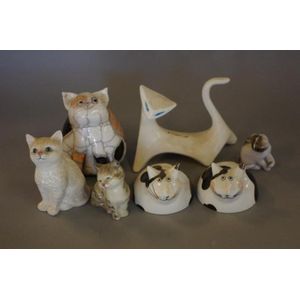Bone China Animal Figurines and Thimbles Set
You must be a subscriber, and be logged in to view price and dealer details.
Subscribe Now to view actual auction price for this item
When you subscribe, you have the option of setting the currency in which to display prices to $Au, $US, $NZ or Stg.
- Bone China - Bone china, Also called 'English china", is one of the three types of porcelain, the other two being soft paste porcelain and hard paste porcelain.
Porcelain is an ancient ceramic material, first made in China, hence the common name "china", and the introduction of bone china was to counter the imports of Chinese porcelain.
The initial development of bone china is credited to Josiah Spode, who introduced it around 1800 and it was soon after copied by other manufacturers including Minton, Coalport, Davenport, Derby, Worcester, Wedgwood and Rockingham and the Herculaneum factory at Liverpool.
Spode's bone china was made by mixing ash from cattle bones with feldspar and kaolin, which created a material that was stronger, more translucent, and whiter than traditional porcelain. He began to produce this new type of porcelain in 1796 and it quickly became very popular.
At the time, the process and ingredients were kept secret and were only known to a few manufacturers and were protected by patents.
In the 19th century, bone china became increasingly popular and was widely produced by many manufacturers in England. During this time, it was considered a luxury item and was often used to create fine dining sets and other decorative items.
Bone china is still used in the production of fine porcelain wares, such as tea sets, figurines, and other decorative pieces. His basic formula of six parts bone ash, four parts china stone, and three and a half parts china clay remains the standard English body. It is still considered a luxury item due to its strength, translucency, and whiteness, and is often used for high-end and high-quality porcelain. China.
This item has been included into following indexes:
Visually similar items

Two Royal Doulton cat figurines & 5 others, including Villeroy & Boch, Grizelle, etc, 11.5 cm high (tallest)

Three various Sylvac dog figures including dog and cat with top hat form vase, marked to base and # 1484, (height 10 cm approx); seated dog, marked # 1433; and seated dog, marked Made in England.

Two Japanese carved okimono, Meiji period, one of a flower merchant with a small boy with incised mark kyokusei, and the other of two fighting toads, Flower merchant: 8 cm wide (2). Provenance: NSW Private Collection

A pair of mammoth tusk figures of rhinoceros, 20th century, each realistically carved striding forward on short legs with head turned slightly to one side, mouth partly open and ears raised in alert attitude, the large head supporting two horns and with sm
